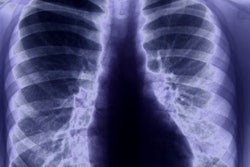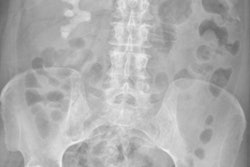
A new study of near-miss errors in radiology has found that portable chest radiography was the modality with by far the largest number of close calls related to either wrong-patient or wrong-dictation mistakes, according to results published in the August issue of the American Journal of Roentgenology.
In an analysis of more than 1.7 million exams performed at Emory University over four years, researchers found 67 cases in which the wrong patient was involved, images were mislabeled, or the wrong case was interpreted by a radiologist. Portable chest x-ray was involved in 69% of these mislabeling or misidentification events and in 44% of the wrong-dictation close calls (AJR, Vol. 205:2, pp. 337-343).
While the use of digital radiography (DR) has reduced some of the types of near-miss events that occurred during the study period, better tools are still needed to help imaging facilities avoid potential errors, according to the researchers.
Error reduction in radiology
The problem of errors in medicine has received increased attention since a landmark Institute of Medicine report in 1999 estimated that preventable medical errors cause 44,000 to 98,000 deaths each year in U.S. hospitals. A more recent analysis by James et al in 2013 found that the number of deaths could be as high as 400,000.
A related problem is near-miss errors -- events in which the wrong patient or study was involved in the care process, but the issue was resolved before any patient harm occurred. Because no injury takes place, such events are often underreported, and they represent a sort of tip of the medical error iceberg, said Emory researchers Dr. Kimberly Applegate and Dr. Srini Tridandapani, PhD.
"The real scope of these errors is probably much larger," Tridandapani said in interview with AuntMinnie.com. "We either never discover them, or we discover them but there is no standard way for dealing with them."
The researchers decided to investigate the prevalence of near-miss events by performing a search of their institution's RIS database for studies completed between January 2009 and May 2013, focusing on the keywords "incorrect patient" or "wrong patient." They defined near-miss events as ones that were potentially harmful but were recognized and corrected before harm resulted.
They also defined three main types of wrong-patient events:
- Misidentified-patient events, which were typically potential errors in patient identification, such as when a radiologic technologist identified the incorrect patient for an imaging study
- Mislabeled-patient events, in which the correct patient was imaged but the images were placed in another patient's folder in the PACS
- Wrong-dictation events, such as when images were placed in the correct PACS folder, but another patient's images were reviewed in error
The researchers then classified the events by imaging modality, time of day, and clinical setting, such as inpatient or outpatient. They also calculated the time from the occurrence of the event to when it was identified, based on time stamps in radiology reports.
The study covered a total of 1,717,713 imaging exams acquired over the four-year study period, during which 67 near-miss events were identified, for an error rate of four per 100,000 imaging exams. In all, 35 events (52%) were classified as mislabeling or misidentification events, and 32 (48%) were considered to be wrong-dictation events.
Of the 35 mislabeling/misidentification events, portable radiography made up by far the largest proportion, as indicated below.
| Near-miss radiology events by modality | ||
| Modality | No. of mislabeling/misidentification events (percentage) | No. of wrong-dictation events (percentage) |
| Portable chest x-ray | 24 (69%) | 14 (44%) |
| Nonportable x-ray and fluoro | 7 (20%) | 5 (16%) |
| CT | 4 (11%) | 2 (6%) |
| MRI | 0 | 1 (3%) |
| Ultrasound | 0 | 1 (3%) |
| Mammography | 0 | 2 (6%) |
| Nuclear medicine | 0 | 5 (16%) |
| Interventional radiology | 0 | 2 (6%) |
In other findings, 63% of the mislabeling/misidentification events occurred in inpatient areas, 28% were in outpatient areas, and 9% were in the emergency department. Wrong-dictation events occurred slightly more often in inpatient areas versus outpatient areas (56% versus 44%), but the occurrence rate in both settings was largely the same, at two events per 100,000 exams.
There was also little difference in the time of day when mislabeling/misidentification events occurred; the rate was two events per 100,000 exams, regardless of whether the time period was during working hours or off hours. Wrong-dictation events occurred slightly more often during working hours, at a rate of two per 100,000, compared with one per 100,000 during off hours.
Wrong-dictation events tended to be discovered more quickly than mislabeling/misidentification events. Dictation events were discovered at a mean time of 86 hours, compared with a mean of 100 hours for mislabeling/misidentification events.
Portable x-ray problems
Why are there so many more problems with portable x-ray? The answer is no secret to any technologist who's had to push a portable unit from room to room, collecting a stack of exposed plates along the way. Radiography's conversion to DR is making the situation somewhat easier, but it's still the most challenging imaging modality, Tridandapani said.
"It's improving with newer technology, but it can still be chaotic," he said. "There are some inherent problems with this modality."
Potential solutions include using barcodes to match patients with radiology orders; barcoding is used frequently in other industries to reduce identification errors. The Emory group has also been researching the use of patient photos that are acquired at the time of an imaging exam and included with the patient's images in the PACS.
Tridandapani led an earlier study that mounted a digital camera on a portable computed radiography (CR) system. Emory hopes to expand on this prototype system with a unit that will be used in clinical testing next year.
While such solutions are novel, reducing medical errors and near misses in radiology over the long term will require more attention to workflow and reporting, as well as national standards for how near misses are reported -- standards that are currently lacking. Until those are in place, radiology's medical errors will remain a problem whose magnitude is unknown.
"We can all expect to make mistakes," Applegate said. "But let's learn from them so we don't hurt the next patient. That's not where we are at right now."



















